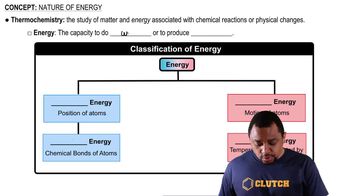Ch.22 - Chemistry of the Nonmetals
Chapter 22, Problem 28
Complete the exercises below. The H₂/O₂ fuel cell converts elemental hydrogen and oxygen into water, producing, theoretically, 1.23 V. What is the most sustainable way to obtain hydrogen to run a large number of fuel cells? Explain.
 Verified step by step guidance
Verified step by step guidance1
Step 1: Understand the context of the problem. The H₂/O₂ fuel cell is a device that converts hydrogen and oxygen into water, releasing energy in the form of electricity. The theoretical voltage produced by this reaction is 1.23 V.
Step 2: Identify the sources of hydrogen. Hydrogen can be obtained from various sources, including natural gas reforming, electrolysis of water, and biological processes. Each method has different environmental and economic impacts.
Step 3: Evaluate the sustainability of each hydrogen production method. Consider factors such as carbon emissions, energy efficiency, resource availability, and environmental impact. For example, electrolysis using renewable energy sources like wind or solar power is considered more sustainable than natural gas reforming.
Step 4: Consider the scalability of the hydrogen production method. For running a large number of fuel cells, the method should be capable of producing hydrogen at a large scale without depleting resources or causing significant environmental harm.
Step 5: Conclude with the most sustainable method. Based on the evaluation, electrolysis of water using renewable energy is often considered the most sustainable way to produce hydrogen for fuel cells, as it minimizes carbon emissions and utilizes renewable resources.
Key Concepts
Here are the essential concepts you must grasp in order to answer the question correctly.
Hydrogen Production Methods
Hydrogen can be produced through various methods, including steam methane reforming, electrolysis, and biomass gasification. Electrolysis, which uses electricity to split water into hydrogen and oxygen, is considered a sustainable method when powered by renewable energy sources. Understanding these methods is crucial for evaluating the sustainability of hydrogen production for fuel cells.
Recommended video:
Guided course

Production of Hydrogen Example
Renewable Energy Sources
Renewable energy sources, such as solar, wind, and hydroelectric power, are essential for sustainable hydrogen production. When hydrogen is produced via electrolysis using electricity from these sources, it minimizes carbon emissions and reliance on fossil fuels. This connection between renewable energy and hydrogen production is vital for achieving sustainability in fuel cell applications.
Recommended video:
Guided course

Nature of Energy
Fuel Cell Efficiency
Fuel cells convert chemical energy directly into electrical energy with high efficiency, typically around 40-60%. The theoretical voltage of 1.23 V for the H₂/O₂ fuel cell indicates its potential energy output. Understanding fuel cell efficiency helps in assessing the overall energy balance and sustainability of using hydrogen as a fuel, as it impacts the feasibility of large-scale applications.
Recommended video:
Guided course

The Electrolytic Cell
Related Practice
